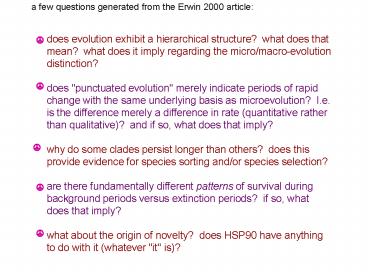a few questions generated from the Erwin 2000 article: - PowerPoint PPT Presentation
1 / 14
Title:
a few questions generated from the Erwin 2000 article:
Description:
a few questions generated from the Erwin 2000 article: ... what does it imply regarding the micro/macro-evolution ... Science, Vol. 238, No. 4825. pp. 360-363. ... – PowerPoint PPT presentation
Number of Views:31
Avg rating:3.0/5.0
Title: a few questions generated from the Erwin 2000 article:
1
a few questions generated from the Erwin 2000
article
does evolution exhibit a hierarchical structure?
what does that mean? what does it imply
regarding the micro/macro-evolution
distinction? does "punctuated evolution" merely
indicate periods of rapid change with the same
underlying basis as microevolution? I.e. is the
difference merely a difference in rate
(quantitative rather than qualitative)? and if
so, what does that imply? why do some clades
persist longer than others? does this provide
evidence for species sorting and/or species
selection? are there fundamentally different
patterns of survival during background periods
versus extinction periods? if so, what does that
imply? what about the origin of novelty? does
HSP90 have anything to do with it (whatever "it"
is)?
2
from the master's mouth...
"Species of the larger genera in each country
vary more frequently than the species of the
smaller genera. If the plants inhabiting a
country as described in any Flora, be divided
into two equal masses, all those in the larger
genera (i.e., those including many species) being
placed on one side, and all those in the smaller
genera on the other side, the former will be
found to include a somewhat larger number of the
very common and much diffused or dominant
species..."
Darwin Origin Ch. 2
3
David Jablonski. 1987. Heritability at the
Species Level Analysis of Geographic Ranges of
Cretaceous Mollusks. Science, Vol. 238, No.
4825. pp. 360-363.
4
David Jablonski. 1987. Heritability at the
Species Level Analysis of Geographic Ranges of
Cretaceous Mollusks. Science, Vol. 238, No.
4825. pp. 360-363.
5
range of mutant phenotypes associated with HSP90
mutations
Suzanne L. Rutherford, Susan Lindquist (1998)
Hsp90 as a capacitor for morphological
evolution. Nature 396, 336 - 342
6
a plausible basis for this type of result
HSP90 mutant homozygote
(deformed eyes)
HSP90 mutant heterozygote
Suzanne L. Rutherford, Susan Lindquist (1998)
Hsp90 as a capacitor for morphological
evolution. Nature 396, 336 - 342
7
(No Transcript)
8
Biological
a fossil!
physical
chemical
Hans Hoffman "Microbial manifestations and
primeval stromatolites" GSA annual meeting,
Seattle 2003
9
biologic, right?
Juan Manuel García Ruiz, Anna Carnerup, Andrew G.
Christy, Nicholas J. Welham and Stephen T. Hyde
(2002) Morphology An ambiguous indicator of
biogenicity. Astrobiology 2353-369
10
wrong!
Juan Manuel García Ruiz, Anna Carnerup, Andrew G.
Christy, Nicholas J. Welham and Stephen T. Hyde
(2002) Morphology An ambiguous indicator of
biogenicity. Astrobiology 2353-369 (and
following page figure as well)
11
(No Transcript)
12
well crap! now what do we do?
look for "degradational features" - that
indicates biogenic activity look for "biofabric
relationships" of original cells
conophytes fit the bill, are as old as 3.46
bya, and can't be reproduced abiogenicallly ....y
et
Hans Hoffman "Microbial manifestations and
primeval stromatolites" GSA annual meeting,
Seattle 2003
Patrick JEAN / muséum d'histoire naturelle de
Nantes
http//folk.uio.no/oyengen/geo/morocco/
13
the ion microprobe to the rescue!
14
the key is that the d13C composition is different
in carbonate biologic specimens































